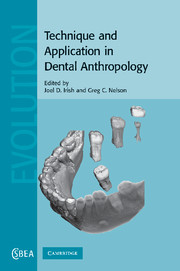Book contents
- Frontmatter
- Contents
- Contributors
- Acknowledgments
- Section I Context
- Section II Applications in assessing population health
- Section III Applied life and population history
- 9 Charting the chronology of developing dentitions
- 10 Dental age revisited
- 11 Primate dental topographic analysis and functional morphology
- 12 Forensic dental anthropology: issues and guidelines
- 13 Inter- and intra-specific variation in Pan tooth crown morphology: implications for Neandertal taxonomy
- 14 The quantitative genetic analysis of primate dental variation: history of the approach and prospects for the future
- Section IV Forefront of technique
- Index
- References
11 - Primate dental topographic analysis and functional morphology
Published online by Cambridge University Press: 12 September 2009
- Frontmatter
- Contents
- Contributors
- Acknowledgments
- Section I Context
- Section II Applications in assessing population health
- Section III Applied life and population history
- 9 Charting the chronology of developing dentitions
- 10 Dental age revisited
- 11 Primate dental topographic analysis and functional morphology
- 12 Forensic dental anthropology: issues and guidelines
- 13 Inter- and intra-specific variation in Pan tooth crown morphology: implications for Neandertal taxonomy
- 14 The quantitative genetic analysis of primate dental variation: history of the approach and prospects for the future
- Section IV Forefront of technique
- Index
- References
Summary
Introduction
Researchers often use tooth form/function relationships in living primates to reconstruct the diets of early hominins and other fossil primates. One relatively new approach that has become an important tool for dental anthropologists is dental topographic analysis (see Teaford and Ungar, 2006; Ungar, 2006, 2007; Ungar and Daegling, 2007 for recent reviews). In this chapter, we summarize briefly this approach in the context of earlier studies of primate dental functional morphology, and present some new data to illustrate how dental topographic analysis works.
Here we present our first dental topographic analysis of Old World monkeys. Preliminary results for Cercocebus torquatus atys and Procolobus badius badius suggest that these primates: (1) follow the same patterns of decreasing occlusal slope and relief with wear evinced by apes, New World monkeys, and lemurs examined in previous studies, (2) differ from one another in occlusal slope and relief as expected, given dietary differences reported in the literature, and (3) have, on average, more occlusal slope and relief than do apes with similar diets at given stages of wear.
Historical background
Researchers have considered relationships between diet and tooth form in primates for a very long time. Gregory (1922), for example, suggested that molar shape evolved primarily to improve mechanical efficiency for chewing. Workers in the 1970s (e.g. Crompton and Sita-Lumsden, 1970; Kay and Hiiemae, 1974) built on this idea, viewing teeth as guides for masticatory movements.
- Type
- Chapter
- Information
- Technique and Application in Dental Anthropology , pp. 253 - 265Publisher: Cambridge University PressPrint publication year: 2008
References
- 10
- Cited by



